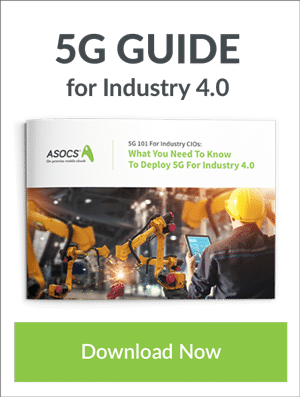
ASOCS reached a major breakthrough in May 2022 CYRUS® release – Network Slicing, its private network 5G offering can now offer both eMMB (Mobile Broadband) and URLLC (Ultra-Reliable Low Latency Communication), as a standard on a single system, based on application, device, and customer needs.
Leaving the boxed solution
Back in 2019 ASOCS released Private 5G in a box – EVK. In one case you got everything you need to set up a quick Private 5G Network for evaluating the potential use cases including a server with Edge, core, switches, CYRUS® RAN software, cables, and a radio unit. For that moment in time, P5G in a box was a perfect solution.
Roll forward use 3 short years and a number of factors have changed the landscape:
- Supply chain crisis
- The move from lab to floor
- The need for scalability
- Futureproofing
The restriction of a solution in a box has already become irrelevant in meeting the needs of the market – failing to meet all three criteria above.
Interoperability is the key to the future
To meet the main challenges of scalability and mitigating the supply chain crisis, interoperability is key. In order to be interoperable, we need to dispense with boxed solutions. A box by definition is confinement; the only containers ASOCS sees in the future are Kubernetes and certainly not a physical container.
A future-proof scalable system that is free from supply chain issues can only be achieved by being agnostic to hardware both in terms of where it resides and what it connects to. The more concurrent vendors it can be connected to the more scalable, flexible, and sustainable the solution can be.
In order to be interoperable, we need to dispense with boxed solutions
For example, a plant wants to extend the coverage of the network to cover both indoor and outdoor – not add new zones but extend one seamless, uniform, and centrally managed network. An open system, such as CYRUS® achieves this by simply adding more Radio Units and possibly adding additional computing power to the edge.
A box by definition is confinement; the only containers ASOCS sees in the future are Kubernetes
Even if there were no global supply chain issues in obtaining new RUs, it would still be beneficial to the plant to be able to source suppliers locally for faster logistics and local technical support and to be able to choose the right units for the right needs and to use a range of units to suit each need. These are the seminal principles of how ASOCS is developing Private 5G – meeting the challenges of today while building the foundations for tomorrow and beyond.
Even a Box is not a Box
Unhindered and unconfined to a self-inflicted box allows the network management to be deployed or even moved to a multitude of server options from managed clouds like Azure to locally procured servers such as Dell or HPE. Being server agnostic means that enterprises are not restricted to predefined hardware setup but are free to choose the configuration that suits their needs and corporate culture. Even the vRAN components for Industrial 5G can be split in a multitude of ways from all being deployed on a single local stack edge to a core on the cloud, CU on the edge, and DUs distributed over multiple sites.
The Future of Private 5G
Free from the shackles of a box, ASOCS sees a future fast approaching where adaptability and flexibility will be key. Private Network slicing will become more complex, eventually being managed dynamically and autonomously via AI. AI on Private 5G and Private 5G on AI working hand in hand with ever more complex use cases. Kubernetes will become key in providing the flexibility and scalability required. Networks will not react to data but act on data.




